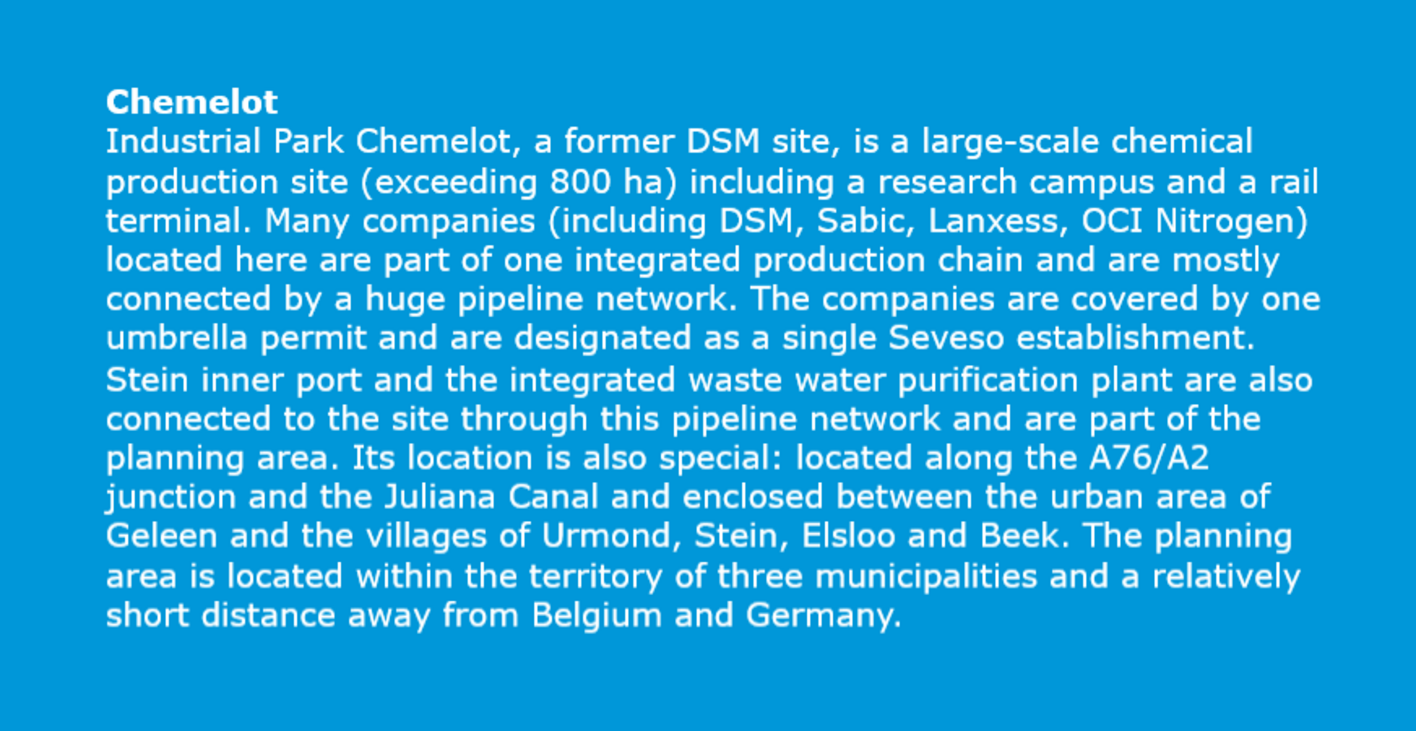Chemelot partial local environment plan: a complex transition
With the advent of the Environment and Planning Act on the horizon, Witteveen+Bos was asked to coordinate the updating of Chemelot’s existing planning framework. Witteveen+Bos was contracted by the municipalities of Sittard-Geleen, Beek and Stein and the province of Limburg to – in close consultation with Chemelot – arrive at a partial local environment plan that is as policy-neutral as possible. This is a complex and challenging process.
A local environment plan (or part of one) must, according to the new planning laws, ‘ensure a balanced allocation of functions to locations’. It will be the successor to the zoning plan.
‘The scope is broad: there are many stakeholders, the site falls within several municipal boundaries and the stakes are high – for instance, the climate challenge of Dutch industry, which must be fossil-free by 2050. It is our role to ensure this process runs smoothly,’ said Thomas De Wilde, planner at Witteveen+Bos. The Witteveen+Bos team, consisting of Thomas, Maurits Schilt and Milan Storms, has been working on the Chemelot partial local environment plan since the summer of 2021.
Connected in a complex network
‘The aim of a partial local environment plan is clear. Chemelot occupies an extensive site (see text frame) adjacent to several residential areas in different municipalities. The core is the Industrial Park where heavy chemical production facilities are located. There is also the Brightlands Campus where study programmes are taught and applied research is conducted on, for example, making chemical processes more sustainable.’
‘Some of the activity, including waste water purification, takes place in and near the Port of Stein. All this is highly interconnected through a complex network of railway tracks, roads and pipelines. Since Chemelot is located in both the municipality of Sittard-Geleen and the municipality of Stein, the municipalities want to avoid different regulations applying to the site. Hence the partial local environment plan.’
Partial local environment plan
This partial plan will be one of the building blocks of the area-wide local environment plan of the aforementioned municipalities. Each municipality chooses its own set-up. Other partial plans may, for instance, include residential areas, the countryside or other business parks. As industrial parks, Chemelot and the Port of Stein have a special status given their profile and scale.
‘This partial environmental plan is important for the physical living environment around Chemelot,’ Thomas says. ‘It is essential that the environmental effects of the proposed plan are also unambiguously, consistently and traceably given a place in the new planning rules or in the explanatory notes of the partial local environment plan – the current environmental impacts, but also the future impacts, now that we know that industry is switching to sustainable energy sources and circular production methods towards 2050. These environmental impacts do not stop at the plan boundary.’
Smoothing out creases
‘As mentioned, this is a policy-neutral transition: the current spatial regime, enshrined in existing zoning plans, regulations, permits and exemptions, will be transferred one-to-one to the partial local environment plan. This will remove some bottlenecks. In the current situation, companies and licensing authorities sometimes face unworkable rules that in practice create an additional, often unnecessary, licensing procedure. We will smooth out these creases in the local environment plan.’
Ensuring health
Drafting this particular local environment plan is no easy task. A wide range of activities – with accompanying effects on the physical living environment – are performed on the vast Chemelot site. Aspects such as odour, noise and safety, but also air quality are considered.
‘Within the partial local environment plan, we ensure that the health of the local residents under the new rules enjoys the same or better protection as in the old situation. This also applies to flora and fauna, for example. Within the sphere of influence of this industrial park are several domestic and foreign Natura 2000 sites along the Border Meuse. The impact on these natural areas – for example, through nitrogen deposition – must not be increased by the new planning rules for this industrial park. This means that we must consider all these interests simultaneously with the business activities in an integrated way and secure them in the partial local environment plan.’
Strong project approach
Currently – in the last quarter of 2022 – it is not yet clear when the local environment plan will be delivered. This is partly due to the Environment and Planning Act, the introduction of which has been delayed until 1 July 2022.
‘The partial plan is gradually taking concrete shape. This takes time, but it also provides unique insights and lessons we can learn from working with the new plan form and under a new legal system. The complexity of this assignment requires the use of various internal and external specialists. Combine that with multiple clients and the diverse group of stakeholders and you can understand why a strong project approach and coordination are required. This is where Witteveen+Bos can distinguish itself. In this sense, the project is a good test case.’
Contact

